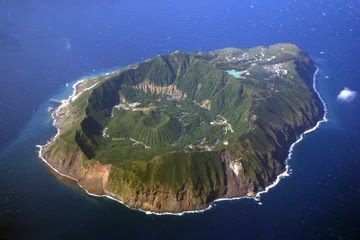Approximately 230 years have elapsed since the last volcanic eruption claimed the lives of half the island's inhabitants. Nevertheless, the local population refuses to allow the volcano to dictate their destiny.
For the denizens of Aogashima, an island situated approximately 200 miles directly south of Tokyo, the year 1785 is etched indelibly in their collective memory. Although they were not present to bear witness to the deadliest event in the island's history, they are well-acquainted with the tragic events of that time a knowledge that has not swayed their resolve to reside upon this very real, active volcano.
The islanders have heard the tales recounting how, on May 18th, the earth trembled beneath their feet. Enormous plumes of gas and smoke erupted from the maw of the island's volcano, propelling rocks, mud, and other debris high into the sky. By June 4th, the island's population of 327 was left with no alternative but to evacuate, with only about half managing to escape, while the rest met a tragic fate. Those who call this island home, a place housing a volcano still deemed active by the Japanese Meteorological Agency the governmental organization tasked with overseeing the nation's 110 active volcanoes are acutely aware that history might one day repeat itself. Nevertheless, the residents of Aogashima are willing to embrace this risk.
Among them is Masanubu Yoshida, a government employee who has called the island home for the past 15 years. He endeavors not to dwell excessively on the prospect of another eruption. Indeed, over 230 years have passed since the last eruption, and thus far, fortune has favored the island's inhabitants.
"One cannot prevail against the forces of nature," he confides in Smithsonian.com. Instead of fixating on potential calamities, the 40-year-old gentleman directs his attention to the advantages of residing in this verdant paradise, shaped by the remnants of four overlapping calderas dating back centuries. A substantial portion of the village is nestled within the outer crater's rim.
For many residents, fishing is a beloved pastime, given the island's location in the midst of the Philippine Sea. Additionally, activities such as hiking, camping, and swimming though access to the water can be challenging due to the island's steep, rocky cliffs outside the harbor enjoy popularity.
"We are also bestowed with natural hot springs and geothermal energy, courtesy of the volcano," he adds. As one tourist who chronicled their visit to one of the island's natural saunas remarked, food can be cooked by placing it atop one of the sauna's steam vents. The sauna even provides an array of pots and pans ready for boiling eggs and other snacks.
While Yoshida holds a desk job, many of his neighbors are engaged in farming and fishing. In addition to vast expanses of lush greenery, the island hosts a shochu distillery a spirit akin to vodka and Japan's national libation a salt production facility, various general stores, a bed-and-breakfast establishment, and an automotive repair workshop. Despite the island's modest dimensions, most residents opt for automobiles as their primary mode of transportation, as opposed to biking or walking a choice driven by practical considerations.
"People are reluctant to bike due to the prevailing strong winds and frequent rain," Yoshida observes. "If you don't drive, you're left with no choice but to walk."
Aogashima boasts several roadways, with the majority meandering through the heart of the island. Yet, despite the handful of more cosmopolitan diversions available on the island, Aogashima remains in stark contrast to life on Japan's mainland. Yoshida, due to his occupation, makes numerous trips to Tokyo each year, typically via a ferry that traverses the 200-mile expanse of sea. Alternatively, one can opt for helicopter travel. However, the bustling metropolis of Tokyo, with its approximately 13.4 million inhabitants, overwhelms him, making him yearn for the solitude he finds upon returning to his island sanctuary.
"I often journey to the mainland for business, but I find the congestion intimidating there are simply too many people," he reflects. "[On Aogashima], we can bask in the grandeur of nature, an experience that eludes those dwelling in bustling urban centers."
Fortunately for Yoshida and his fellow islanders, the volcano has remained dormant thus far. According to the Japan Meteorological Agency, which began issuing alerts in 2007, no volcanic warnings have been raised for Aogashima in the past nine years. Each new day dawns as another day in paradise for the islanders at least for now.










0 Comments